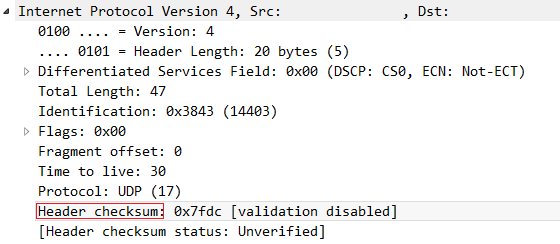To be clear, the IP Header Checksum helps protect against errors in the IP header only, and not with errors in the payload. This is by design. For further reading, refer to RFC 791 INTERNET PROTOCOL:
1.4. Operation
The Header Checksum provides a verification that the information used
in processing internet datagram has been transmitted correctly. The
data may contain errors. If the header checksum fails, the internet
datagram is discarded at once by the entity which detects the error.
3.1. Internet Header Format
Header Checksum: 16 bits
A checksum on the header only. Since some header fields change
(e.g., time to live), this is recomputed and verified at each point
that the internet header is processed.
The checksum algorithm is:
The checksum field is the 16 bit one's complement of the one's
complement sum of all 16 bit words in the header. For purposes of
computing the checksum, the value of the checksum field is zero.
This is a simple to compute checksum and experimental evidence
indicates it is adequate, but it is provisional and may be replaced
by a CRC procedure, depending on further experience.
3.2. Discussion
Checksum
The internet header checksum is recomputed if the internet header is
changed. For example, a reduction of the time to live, additions or
changes to internet options, or due to fragmentation. This checksum
at the internet level is intended to protect the internet header
fields from transmission errors.
There are some applications where a few data bit errors are
acceptable while retransmission delays are not. If the internet
protocol enforced data correctness such applications could not be
supported.
For implementations of the Internet Checksum, refer to RFC 1071 Computing the Internet Checksum along with its Errata, RFC 1141 Incremental Updating of the Internet Checksum and RFC 1624 Computation of the Internet Checksum via Incremental Update, which corrects a mistake made in RFC 1141.
If you’re interested in the UDP Checksum, refer to RFC 768 User Datagram Protocol, where you’ll find:
Checksum is the 16-bit one's complement of the one's complement sum of a
pseudo header of information from the IP header, the UDP header, and the
data, padded with zero octets at the end (if necessary) to make a
multiple of two octets.
The pseudo header conceptually prefixed to the UDP header contains the
source address, the destination address, the protocol, and the UDP
length. This information gives protection against misrouted datagrams.
This checksum procedure is the same as is used in TCP.
0 7 8 15 16 23 24 31
+--------+--------+--------+--------+
| source address |
+--------+--------+--------+--------+
| destination address |
+--------+--------+--------+--------+
| zero |protocol| UDP length |
+--------+--------+--------+--------+
If the computed checksum is zero, it is transmitted as all ones (the
equivalent in one's complement arithmetic). An all zero transmitted
checksum value means that the transmitter generated no checksum (for
debugging or for higher level protocols that don't care).
Since RFC 768 indicates that, “This checksum procedure is the same as is used in TCP.", you might also want to have a look at RFC 793 TRANSMISSION CONTROL PROTOCOL, where the Checksum field is described as follows:
Checksum: 16 bits
The checksum field is the 16 bit one's complement of the one's
complement sum of all 16 bit words in the header and text. If a
segment contains an odd number of header and text octets to be
checksummed, the last octet is padded on the right with zeros to
form a 16 bit word for checksum purposes. The pad is not
transmitted as part of the segment. While computing the checksum,
the checksum field itself is replaced with zeros.
The checksum also covers a 96 bit pseudo header conceptually
prefixed to the TCP header. This pseudo header contains the Source
Address, the Destination Address, the Protocol, and TCP length.
This gives the TCP protection against misrouted segments. This
information is carried in the Internet Protocol and is transferred
across the TCP/Network interface in the arguments or results of
calls by the TCP on the IP.
+--------+--------+--------+--------+
| Source Address |
+--------+--------+--------+--------+
| Destination Address |
+--------+--------+--------+--------+
| zero | PTCL | TCP Length |
+--------+--------+--------+--------+
The TCP Length is the TCP header length plus the data length in
octets (this is not an explicitly transmitted quantity, but is
computed), and it does not count the 12 octets of the pseudo
header.</code></pre></div><div class="answer-controls post-controls"></div><div class="post-update-info-container"><div class="post-update-info post-update-info-user"><p>answered <strong>22 Oct '17, 07:08</strong></p><img src="https://secure.gravatar.com/avatar/55158e2322c4e365a5e0a4a0ac3fbcef?s=32&d=identicon&r=g" class="gravatar" width="32" height="32" alt="cmaynard's gravatar image" /><p><span>cmaynard ♦♦</span><br />
9.4k●10●38●142
accept rate: 20%


Thank you very much. It works.